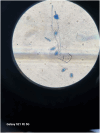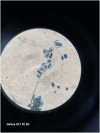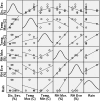Integrating weather indices with field performance of novel fungicides for management of late blight of potato (Phytophthora infestans) in North Eastern Himalayan Region of India
- PMID: 39637033
- PMCID: PMC11620572
- DOI: 10.1371/journal.pone.0310868
Integrating weather indices with field performance of novel fungicides for management of late blight of potato (Phytophthora infestans) in North Eastern Himalayan Region of India
Abstract
The hemibiotrophic fungus-like oomycete phytopathogen, Phytophthora infestans (Mont.) de Bary, causing late blight disease of potato, is one of the most serious foliar diseases of potato. The pathogen spread very rapidly and can infect at any stage of crop growth.The field experiments were carried out during winter (rabi) season of 2020-21 and winter (rabi) season of 2021-22 to find out the correlation between the disease progress and environmental factors and the effective novel fungicides registered under Central Insecticide Board and Registration Committee (CIB&RC) against P. infestans. Results revealed that T7: Mandipropamid 23.4% SC @ 0.1% (1.0 ml/L) at 35 & 55 days after sowing (DAS) and Ametoctradin 27% + Dimethomorph 20.27% SC @ 0.1% (1.0 ml/L) at 45 & 65 DAS recorded least average per cent late blight disease incidence (PLBDI) of 13.00 and 9.33, per cent late blight disease severity/index (PLBDS) of 8.81 and 5.96 and maximum tuber yield of 21.58 and 21.86 t/ha with highest benefit cost ratio (BCR) value of 1:1.95 and 1: 1.99 as compared to control during winter (rabi) season of 2020-21 and winter (rabi) season of 2021-22, respectively. T7 exhibited minimum Area under the Disease Progress Curve (AUDPC) value during both the consecutive seasons. The disease is positively correlated with maximum and minimum temperature, morning and evening relative humidity and sunshine hours. Linearity assumption scatter matrix indicates coefficient of determination of 0.916 was calculated using the pooled data.The relative potato tuber yield loss ranged from 7.38 to 19.96% and 7.14 to 19.62% during 2020-21 and 2021-22, respectively. Spray schedule with contact fungicide followed by systemic/translaminar + contact fungicide recorded reduced potato late blight disease with highest BCR value under natural epiphytotic condition.
Copyright: © 2024 Dey et al. This is an open access article distributed under the terms of the Creative Commons Attribution License, which permits unrestricted use, distribution, and reproduction in any medium, provided the original author and source are credited.
Conflict of interest statement
The authors have declared that no competing interests exist.
Figures













Similar articles
-
Endophytic Bacillus subtilis H17-16 effectively inhibits Phytophthora infestans, the pathogen of potato late blight, and its potential application.Pest Manag Sci. 2023 Dec;79(12):5073-5086. doi: 10.1002/ps.7717. Epub 2023 Aug 23. Pest Manag Sci. 2023. PMID: 37572366
-
Environmental impact and phenotypic stability in potato clones resistant to late blight Phytophthora infestans (Mont) de Bary, resilient to climate change in Peru.PLoS One. 2025 Feb 11;20(2):e0318255. doi: 10.1371/journal.pone.0318255. eCollection 2025. PLoS One. 2025. PMID: 39932991 Free PMC article.
-
A new strategy for durable control of late blight in potato by a single soil application of an oxathiapiprolin mixture in early season.PLoS One. 2020 Aug 21;15(8):e0238148. doi: 10.1371/journal.pone.0238148. eCollection 2020. PLoS One. 2020. PMID: 32822425 Free PMC article.
-
Genetic factors encoding resistance to late blight caused by Phytophthora infestans (Mont.) de Bary on the potato genetic map.Cell Mol Biol Lett. 2004;9(4B):855-67. Cell Mol Biol Lett. 2004. PMID: 15647802 Review.
-
How Does Phytophthora infestans Evade Control Efforts? Modern Insight Into the Late Blight Disease.Phytopathology. 2018 Aug;108(8):916-924. doi: 10.1094/PHYTO-04-18-0130-IA. Epub 2018 Jul 6. Phytopathology. 2018. PMID: 29979126 Review.
References
-
- Das R. and Jha K.K. (2022). Information sources utilization among potato farmers in north east India. Indian Res. J. Ext. Edu. 22 (1):44–49.
-
- Thapa S. and Thapa S. (2019). Scope of Value- addition in Potato. International journal of Horticulture, Agriculture and Food Science. 3(3):132–146.
-
- Doboch M. Gedebo A. Haile A. and Beshir H. M. (2022). Improving potato productivity through optimum agronomic management to ensure food security of smallholder farmers. Cogent Food & Agriculture, 8:1–13, doi: 10.1080/23311932.2022.2131995 - DOI
-
- FAO (2019). FAOSTAT, FAO Statistical Databases.
MeSH terms
Substances
LinkOut - more resources
Full Text Sources

